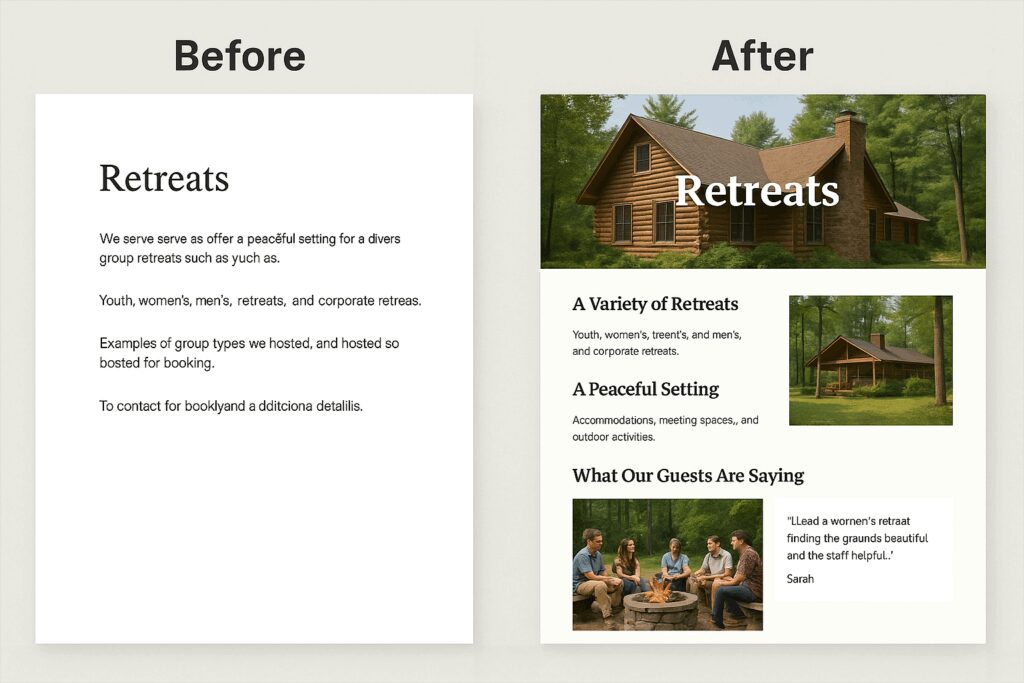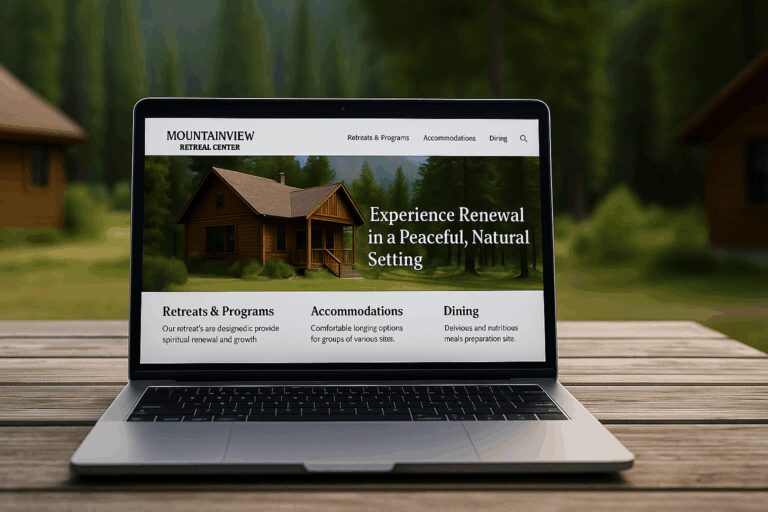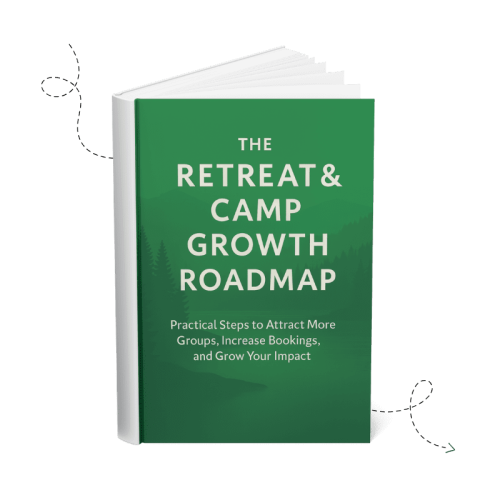Retreat & Camp Growth Roadmap Focus Area: Develop Organic Traffic
Introduction
You already have a website. The question is: is it really working to bring in group bookings? Many retreat centers and camps describe their programs, facilities, and dining online—but too often, those pages don’t show up in Google search results or don’t give group leaders enough reason to inquire.
That’s where SEO (Search Engine Optimization) comes in. SEO for retreat centers and camps ensures your content appears in search results when group leaders are looking for a place to host their event. By optimizing your existing website content, you can attract more qualified visitors, answer their questions, and guide them toward booking with you.
This article will show you how to turn your current website into a tool for Christian camp marketing and retreat marketing that consistently generates inquiries and supports your mission.
Why This Focus Area Matters
On-page SEO is more than just “ranking higher on Google.” It’s about clarity, trust, and making your website more helpful to group leaders. When your content is optimized, you not only become easier to find in search results—you also become easier to choose as the right location for a group’s retreat.
The benefits are significant. Optimized pages make your retreats and programs visible to people searching for them, help visitors quickly get answers to their most important questions, and position your website as a 24/7 outreach tool that attracts the right groups.
For directors and program leaders, this is also about stewardship. You’re already investing in a website. SEO makes that investment work harder, helping you fill your calendar and multiply your impact. Now let’s explore how to know if this is the right area of focus for you right now.
Is This an Area You Need to Focus on Right Now?
Before investing time in SEO, it’s important to check whether this should be your priority. A few quick reflection questions will help you see if this is an area where your retreat center or camp needs improvement.
Ask yourself:
- Do my retreat pages appear in Google when I search for things like “youth retreat center near [city]”?
- Does my website clearly explain what we offer for different group types?
- Do my most important pages link to each other logically?
- Are there clear next steps for someone who’s interested in booking?
If you answered “no” to any of these questions, then optimizing your website content for SEO is the right next step. This focus area can bring greater clarity to your message, improve alignment between your content and search demand, and expand the impact of your outreach. Let’s begin by looking at what makes a single page optimized.
What Makes a Page Optimized for SEO?
Google doesn’t rank entire websites—it ranks individual pages. That means every page has to carry its own weight if you want your site to perform well. An optimized page balances three key elements:
- Clarity for visitors – A page should be easy to read, well-organized, and answer the questions group leaders are asking.
- SEO signals for search engines – Headings, keywords, links, and alt text help Google understand what the page is about.
- Encouragement to act – Calls to action guide visitors to take the next step toward booking.
When all three work together, you create a page that is useful to people and attractive to search engines. This is the essence of SEO for retreat centers and Christian camp marketing. With this framework in mind, let’s walk through the four key areas of on-page optimization.
Four Keys to Optimizing Your Website Content for SEO
1. Make Pages Clear and Complete
The first key is ensuring that your most important retreat pages answer the who, what, when, where, and why before a group leader ever picks up the phone. Clear, complete pages provide both a better guest experience and stronger signals for search engines.
Practical examples include dedicating a page to each retreat type you serve (youth, women, men, leadership), expanding content with details like lodging, dining, activities, or schedules, adding FAQs based on the questions you hear most often, and weaving in testimonials that naturally mention group types or locations, such as “Our church from Pittsburgh had a fantastic weekend here.”
Questions to consider:
- Do I have a page for each group type I want to attract?
- Would my pages answer a leader’s top questions without them needing to call?
- Are my pages using real voices (testimonials, quotes) to build trust?
When your pages are clear and comprehensive, you not only build trust with visitors but also create content that Google can confidently rank. Once you’ve laid this foundation, the next step is ensuring you’re using the right words and structure so search engines and people can easily understand your content.

2. Use the Right Words and Structure
Finding the right words is at the heart of SEO. Group leaders are already searching Google using terms that describe what you offer—but if your content doesn’t match their language, your pages may never appear in their search results. Beyond keywords, the way your content is structured affects whether visitors stay engaged or click away.
Practical examples include using keyword variations like “youth retreat,” “student retreat,” and “church youth retreat weekend,” writing clear, descriptive headings (H1, H2, H3) that break content into scannable chunks, and optimizing meta titles and descriptions so your page stands out in search results.
Questions to consider:
- What phrases are my guests already using that I could add to my pages?
- Do my page headings make the content easy to skim?
- Would my page title and description in Google make someone want to click?
Choosing the right words and organizing them well builds a bridge between what people are searching for and what you have to offer. This is a core part of SEO for camps and retreat centers: making sure your retreat pages show up in search results and are easy to read once people land on them. Once you have the words in place, the next step is guiding visitors to take meaningful action.
3. Guide Visitors to the Next Step
An optimized page doesn’t just provide information—it helps someone take the next step. Without a clear direction, even the best content can leave a visitor unsure of what to do, and you could miss out on an inquiry.
Practical examples include adding clear calls to action (CTAs) like “Check Availability” or “Plan Your Retreat,” using internal links to connect retreat pages with Facilities, Dining, or Pricing, and linking blog posts directly to retreat pages (for example, “5 Tips for Planning a Youth Retreat” linking to your Youth Retreats page).
Questions to consider:
- If someone lands on one of my retreat pages, is it obvious what to do next?
- Are my key pages linked together in a way that feels natural?
- Do I have blog posts or resources pointing visitors back to my main retreat pages?
Guiding visitors with links and CTAs is not just about improving user experience—it’s also an important SEO strategy. Internal linking shows Google how your content is connected and helps distribute authority across your site. Once you’re guiding visitors well, the final piece is maintaining and improving over time.

4. Maintain and Improve Over Time
SEO is not a one-time project. For camps and retreat centers, it’s a process of steady stewardship—keeping your content fresh, checking performance, and tuning up the technical details that affect rankings and user experience.
Practical examples include reviewing traffic in Google Analytics or Search Console every quarter, updating retreat pages every 3–6 months with fresh details or new FAQs, and monitoring technical factors such as page speed, mobile friendliness, broken links, HTTPS security, accessibility with alt text, and schema markup (extra code that helps Google display FAQs or reviews).
Questions to consider:
- Do I know which of my retreat pages are drawing the most traffic right now?
- When was the last time I updated my core retreat content?
- Have I checked speed, mobile view, and broken links recently?
Maintaining your SEO work ensures that your site remains visible and effective over time. Even small updates made consistently will improve both search rankings and user trust. With this process in place, the question becomes how to best resource the effort.

Resourcing the Effort
SEO content work takes time and consistency. The good news is that much of it can be done in-house without advanced technical skills, such as adding FAQs, refreshing photos, and adjusting links. More complex tasks, like improving page speed or adding schema markup, may require a developer or a Christian camp SEO partner.
Start small. Even optimizing one retreat page this month will move you forward. And if you have the resources, working with retreat marketing agencies or SEO for retreat centers specialists can help you accelerate progress. Either way, it’s better to start than to wait.
On-Page SEO Optimization Worksheet
Optimizing an entire website can feel overwhelming, but the most progress often comes one page at a time. That’s why we created the On-Page SEO Optimization Worksheet—a practical tool to help you evaluate and improve a single page so it performs better in search results and attracts more retreat groups.
📥 Download the On-Page SEO Optimization Worksheet
This worksheet will guide you step by step through defining the page’s purpose, choosing the right keywords, strengthening the content, improving on-page SEO elements, and checking internal links and technical basics. By working through it, you’ll create a clear plan for making one of your most important pages stronger and more visible.
Mini Case Study
A Christian retreat center in Virginia had a website full of content, but it wasn’t showing up prominently in Google search results for important phrases like “Christian retreat center near me” or “youth camp venue near me.” As a result, their site wasn’t driving the level of retreat inquiries they needed.
We helped them address this challenge by focusing on the core pages of their website. First, we prioritized their existing retreat and program pages, mapped each one to important keywords, and optimized the content so it aligned better with what group leaders were searching for. Next, we created new pages to target additional keywords that weren’t addressed by their existing content. Over time, we revisited and updated these pages based on insights from Google Search Console to continually strengthen their performance.
The results were significant. Year over year, the center saw strong growth in both website traffic and retreat inquiries—all by stewarding and optimizing the content they already had.
You can read the full case study here: View the Full Case Study
Putting It All Together
Optimizing your existing website content for SEO doesn’t require starting from scratch. It’s about sharpening what you already have: making your retreat pages clear and complete, using the right words and structure, guiding visitors with calls to action and links, and maintaining improvements over time.
Even small, steady updates create momentum. Think of SEO as faithful stewardship—making the most of what’s already in your hands. With consistency, your website can become a reliable magnet for retreat groups and a key piece of your overall camp marketing strategies.
Ready to Take the Next Step?
SEO for retreat centers and camps is one of the most effective ways to bring in qualified inquiries. The good news is that it starts with simply improving the pages you already have.
If you found this helpful, here are four great next steps to continue your journey:
🧭 Move to the Next Focus Area: Develop Blog Content
Learn how to publish helpful blog content that answers common questions and builds trust.t.
[Read Develop Blog Content Article]
📘 Download the Retreat & Camp Growth Roadmap eBook
Get the full 3-stage system we use to help retreat centers and camps grow with clarity and purpose.
[Download the eBook]
🌱 Learn More About How We Help Retreat Centers & Camps
We’re a Christian-owned digital marketing agency that helps retreat centers and camps grow attendance, bookings, and impact through practical strategies rooted in clarity and stewardship.
[See How We Can Help]
🤝 Schedule a Free Discovery Call
Want help applying this to your unique situation? Let’s talk. We’ll explore where you are now, where you want to go, and how to take the next faithful step.
[Book a Discovery Call]
You don’t have to figure this out alone. Let’s build something meaningful—together.
Frequently Asked Questions
1. How long does it take to see results from SEO content optimization?
Usually a few weeks to a few months. The timeline depends on competition and how much improvement is made.
2. What’s the difference between updating content and creating new content?
Updating means strengthening what you already have. Creating means adding new pages or blogs. Both matter, but SEO updates often bring quicker wins.
3. Do I need coding skills to optimize my website content for SEO?
No. Most changes—headings, text, links, images—require no coding. Tasks like speed fixes or schema may need technical help.
4. Which matters more for SEO: blog posts or program pages?
Program pages should always come first. Blogs work best when they support and link back to those key pages.
5. Do images and videos affect SEO?
Yes. When optimized with alt text and compressed for speed, visuals help with engagement and rankings.
6. How often should I update my content for SEO?
Check your main pages every 3–6 months. Update outdated details, add new FAQs, and refresh photos.
7. How do meta titles and descriptions help with SEO?
They influence whether someone clicks your result in Google. Clear, keyword-rich titles and inviting descriptions increase clicks.
8. What if I don’t know which keywords to target?
Start with the language your guests use. Type those phrases into Google, see what comes up, and refine from there.
9. Should I hire a camp marketing agency or do SEO myself?
If you have time and a willingness to learn, you can make progress on your own. Agencies bring expertise, especially with technical areas, and save time.
10. How important is mobile optimization for SEO?
Very. Many planners first check your site on a phone. If it’s slow or clunky, they may leave before contacting you.





